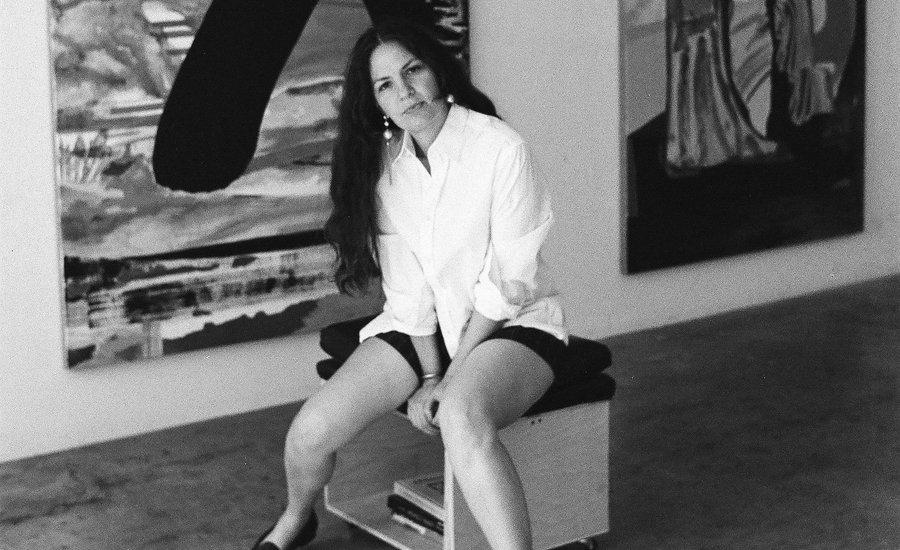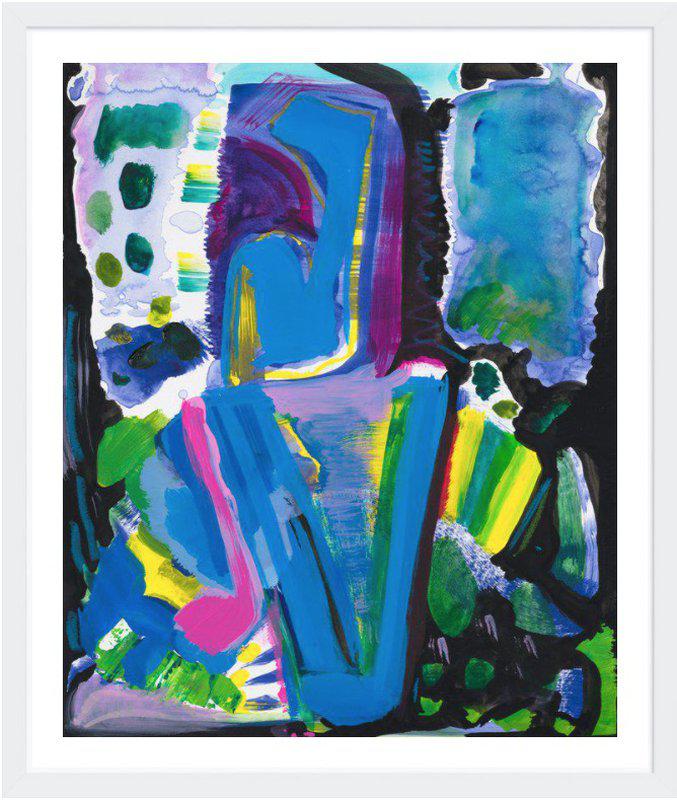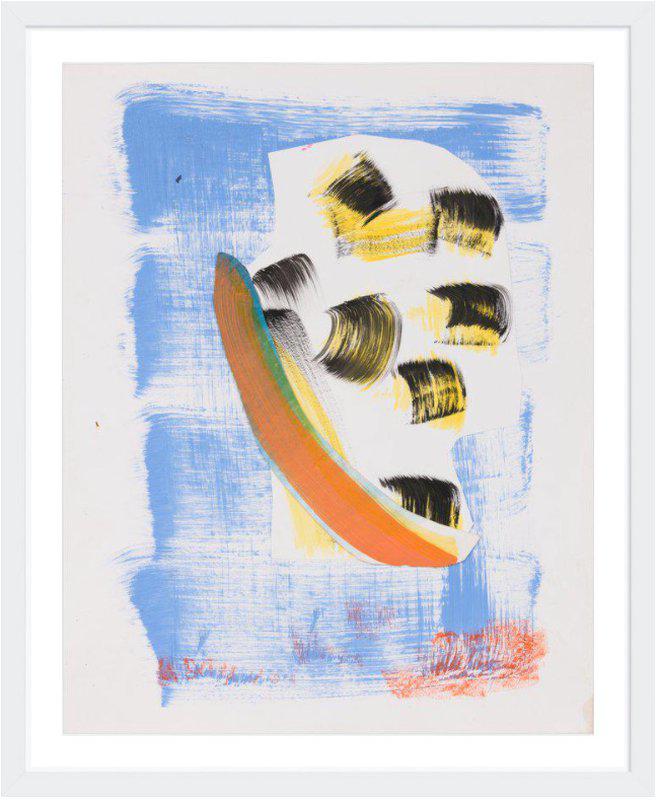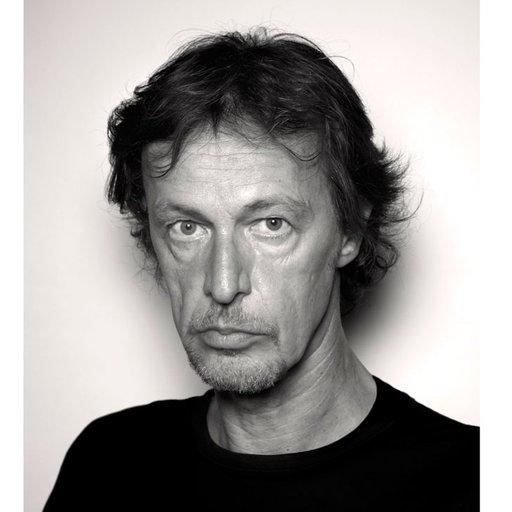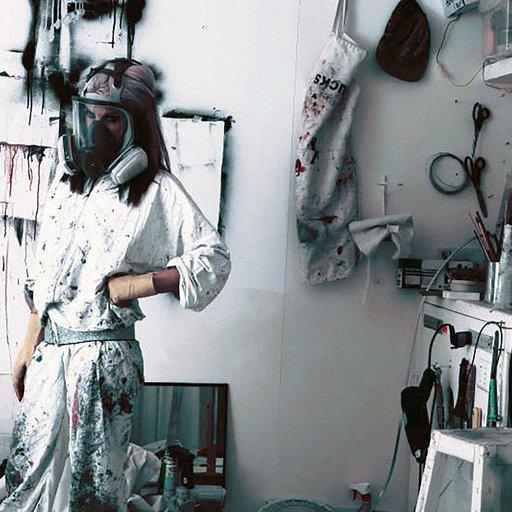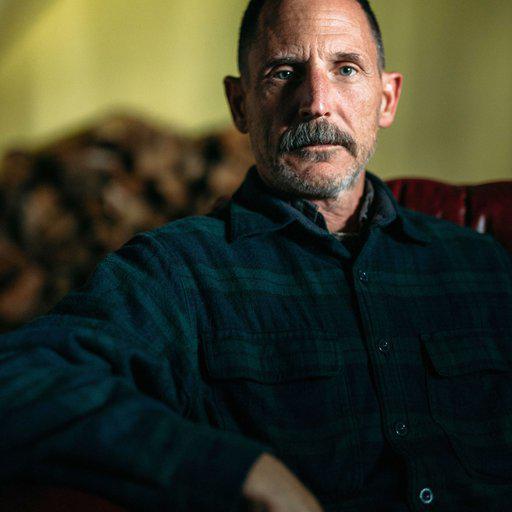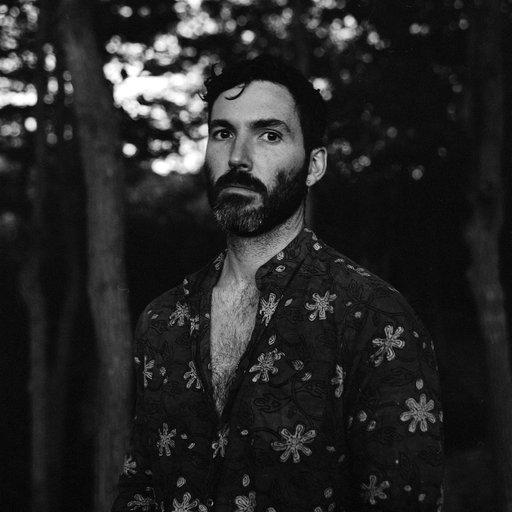Do you detect something dynamic, perhaps even choreographic, in Lindsay August-Salazar’s colorful works? Then you have a pretty good eye; dance runs deep in her work. Born in Los Angeles in 1986, August-Salazar’s earliest form of public expression was via choreography- dance and Southern California’s role in shaping popular culture remain key themes in this cerebral, critical artist’s work. As August-Salazar sees it, a childhood in LA enabled her to better understand the mass production of consciousness, and the ways in which the contemporary can evade its influence.
Many others now share her point of view: her dynamic, abstract works and performances have been featured in group and solo exhibitions across the US and internationally; she has held multiple lecturing and associate professor positions including at University of California, Riverside and Otis College of Art and Design, and has been featured in such illustrious organs as Modern Painters, Hyperallergic and Art in America.
In our continuing series profiling artists who sell directly via our site, August-Salazar describes her artistic outlook, how neuroscience and modernism fits into her work, and why, if she could, she would like to go back to the origins of painting.
How would you describe what you do? Honestly, I would describe my work like Joan Mitchell grabbing Franz Kline’s cock at the Cedar Tavern.
What made you want to become an artist? Before I was an artist I was a commercial hip-hop back up dancer. Growing up in LA, and with a passion for movement and performance from a young age, it happened that the closest studio to my house was the premiere dance studio, turning out the hottest in late 90’s pop culture. I kind of fell into it really. Long story short, I could either end my dance career at 30 or begin my career as an artist. So, I chose UCLA over Julliard. From there, I realized art has the capacity to expand my deeper drive and interest in human expression, connecting larger concepts coming from philosophy of the mind, cognitive science, as well as the organizational rigor of activism and the open terrain to envision and expand the political imagination of the collective to make change through the visual lens of the mind.
LINDSAY AUGUST-SALAZAR - Study-Affirmed Liquid Seewaters Advancing [ACC Study_065], 2021
Image courtesy of the artist. Photograph: Jeff McLane
What was your earliest art creation? You have to understand that I was not even two feet tall walking around the front yard with a paintbrush the size of my face in my tiny hand. I would dip the brush in the water and apply it to the hot bricks in the yard, painting water onto the gridded walkway at my childhood home. Los Angeles is a desert and the water would evaporate rapidly allowing me ample opportunity to paint the water back on. I painted the bricks for hours. Needless to say, the ephemerality of this activity was captivating! I was a very patient child and inherently invested in logic order and systems, but mostly the process. I thought to myself, “wow painting is like magic.” I loved doing this at that confusing dusk/twilight time of day – the magic hour till there was no more seeing light at all. I don’t know if I would actually call this my first work but it definitely was my first introduction to the unique space between painting and performance.
What should people look for in your work? Growing up in L.A., the mass production of consciousness was very clear to me and more so my ability to evade that. The subtle permutations between the negation of a cultural norm and the assertion of an alternative paradigm of thought have written themselves as central through lines within my interest in art. On one level, there are American pop geniuses such as Thomas Kinkade, Mike Kelly, and Andy Warhol. These sensibilities are hybridized in my work against the utopian lineage in early modernism, an underlying contagious desire for liberation innate to all cultures.
The key figures for me are Lygia Clark, László Moholy-Nagy, Sonia Delaunay, Akarova and Sophie Taeuber-Arp. The triumph of this phase of modernism for me is not the negation of the culture that came before it, but the employment of modern life to create a new paradigm of consciousness. Without even being familiar with the critique of spectacle in lettrism, in 2011 a fantasy of letters began to emerge in my work as a tool to navigate proto-fascist power in the United States. The works I produce are like vestiges/windows where the viewer can go into an alternative world to be bewildered or into a space of respite from the exhaustion of restrictive systems of power.
The Abstract Character Copy (ACC) Lexicon was invented and works as a tool to sidestep hegemonic codes. The political dynamics around power are always the subject. Everything else becomes the material support for these questions describing and enhancing the ACCs- like an adverb. The mind has the space to carve around heteronormative, colonial, and capitalist structures and hopefully the viewer can come out with a sense of empowerment.
LINDSAY AUGUST-SALAZAR - Sway Skirmish ( ACC Study 0530_Ao1), 2020
Image courtesy of the artist. Photograph: Jeff McLane
Could you describe your process? Understanding the impetus of expression, in particular, how the structure of language works, means reaching across many branches of psychology and philosophy of the mind—everything from basic neurological functioning to high-level cognitive processing. I believe language shapes our social interactions and brings 'order' to our lives. Complex language is one of the defining factors that makes us human. I began to engage my practice with two concepts that make language unique: grammar and lexicon. To consider how humans acquire, use, and sometimes abuse language is at the core of my process. But to answer your question more clearly, language itself as a scripting system, which you see in dance notation or in John Cage’s musical scores, becomes a direct driver for both my performance and my painting.
On the most literal level each letter in the ACC lexicon translates into a specific dance movement. As the ACCs grew out of my own histories as a dancer, I have an intuitive relationship to the reading and writing to them much in the way that an author understands their own voice. As a result, my body movements work as a form of ideation, first for my drawing and then later for my paintings. While the ACCs are a literal lexicon, the combination and recombination of letter forms has proved to be continually generous for my practice.
Where do your titles come from? Recently the paintings have been accompanied by paired titles, one part is a synthesis of experience removed then reclaimed without judgment and second an archival combination of chapter numerating and coding with the English “translatable” character correlation to the ACC Lexicon.
LINDSAY AUGUST-SALAZAR - Disposition Strategies [ACC Study 0117], 2018
Image courtesy of the artist. Photograph: Jeff McLane
Tell us about three of your works on Artspace My practice is multi-dimensional. I work through a lot of my subject matter in a sort of digestive manner. As a result, I have countless hours of me dancing on film but, also piles of marks on scrolls of big paper- Trisha Brown-esk fashion. From there things narrow down a bit and distil. From my intensive movement research, a prolific mark vocabulary emerges, I see this as the genesis of ideas, drawings are recorded movement and the backbone to my practice. Producing these works on paper, then become organized into 10 chapters. From here some become studies for paintings or nuggets get lifted and held as the theme or atmosphere for larger installation works or performances.
In the work Disposition Strategies [ACC Study 0117], this became a study for a painting in a solo show I did called Marking Repetition at Stene Projects, in Stockholm, Sweden. It was my first show with them and this moment in my work was a time where I was still developing the ACC Lexicon, so I was doing so much repetitious actions to excavate and rehearse this language that really belongs to all of us and none of us.
With Sway Skirmish [ACC Study 0530_Ao1), this work came out of our collective 2020 upheaval. Here in America, this was also election year. A very intense moment, upon viewing and coupled with that title there is a certain amount of loaded potency in the composition between the atmosphere and the two confrontational potential ACC characters. In some way this work, along with the large body of drawings I made in 2020 acted as a gratitude gesture to all the front line health workers, essential workers, local and at large coalitions, alliances, organizers, people who have put their countless hours hearts souls and bodies out there on the lines in the name of maintaining a civil society and democracy. This work was like an ode to upwards and positive change.
And with both Affirmed Liquid Seewaters Advancing [ACC Study_061] and [ACC Study_065], these come out of my most recent body of paintings I just finished. These two works are super direct as in they are extensions of the main painting like when an apple tree blossoms and somehow all three flowers on one leaf turn into apples, though by nature there is a clear difference in size.
LINDSAY AUGUST-SALAZAR - Affirmed Liquid Seewaters Advancing [ACC Study_061], 2021
Image courtesy of the artist. Photograph: Jeff McLane
Do you always begin with a concept in mind or do you sometimes just paint? I was taught from the lineage of California Conceptualism. Concept and paint are one and the same in my work. I’d like to believe I have developed a framework around my practice that allows both sides of my brain to be occupied. I think balance is a really important factor in maintaining curiosity and engagement, not just for myself but also for those who respect my work. Sometimes I do just move, draw, paint, write, or observe. Though the larger pursuit of my practice is pretty consistent, I’d like to think of my work like that of a writer whose syntax and diction matures with time. There might be a set language, but how it is employed, based on the experience and perspective through phases of life, evolves.
How do you get your creativity flowing? Oh creativity gets moving through so many different channels. It could come from me hearing a song at the taco stand down the street from my studio that I capture and then later play back while I am dancing. It could come from a certain passage I am currently reading, or from scanning the latest headline in the news. Sometimes it’s as spontaneous and as fleeting as the way the sunlight hits the wall or the paint combo on a car or covering up graffiti on a building. In the way that Sonya Delany was inspired by the fast-moving automobile, I too am a product of my own time and this experience is made concrete through my choreographic language. The movement of the body (performance) comes first followed by drawing, then painting. However, it is important to note that my dance is actually quite the opposite of my body being a vessel for our moment in capitalism. Instead I draw on my heritage to recompose and hybridize these energies for critical means.
Do you collect art yourself? I do collect and do a lot of trading with fellow artist friends. It is great to think about what it means to have the voices of friends and artists one admires adorning the intimate domestic space- perhaps a sparkle in true utopic fashion. Each party knowing the amount of attentive focus put forth, respectfully generated a form of currency that has an extensive value to the other and then the moment where there is an interchanging of care through vessels of unique making. It is a real honor when you get to a place where you and another artist admire and want to live with one another’s work. My partner and I have quite a collection at this point and it is lovely to walk guests through our home, telling the stories of each acquisition. Currently we have our eyes on a work on paper by Nicola Tyson. This piece will have to be a procurement, though if you are reading this Nicola let’s do studio visit swaps and trade!
 Lindsay August-Salazar photographed by Sita Valrún
Lindsay August-Salazar photographed by Sita Valrún
If you could choose any artist to do your portrait who would it be and what instructions would you give them? You didn’t mention time so I would go back to the Paleolithic age. Like Maurice Merleau-Ponty’s theories of embodied sight, sensory perception and consciousness, it would be so remarkable to sit for an artist of this period. I don’t know what instructions I would give per se, especially considering there are very few portraits discovered or known, but while in this nice time travel fantasy, I would be so eager to grasp some sort of an understanding of this early period in human existence. Today, we can now attempt an answer to the question of how it happened that at one time, in one place, there was no art, and then at some later time art began. But to directly ask, versus infer or closely examine and re-evaluate specific significant affairs would be so fulfilling. Asking questions like what compels them to paint, to replicate what they see and to learn the relationship to the three-dimensionality of the surface of the cave's stone. Having been fortunate enough to visit some of these preserved caves from the Grotte de Rouffignac to the Font-de-Gaume, I catch myself when it’s like 3am on a deadline and in silent focus painting thinking about our deep lineage lost, unknown.











